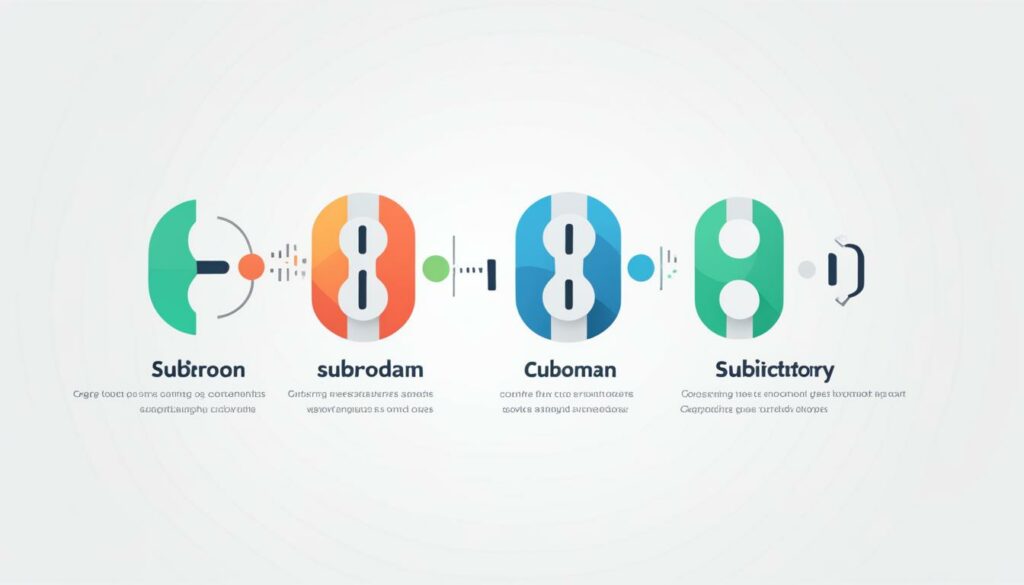Welcome to our guide on subdomains and how they can help you organize your website and improve your SEO efforts. If you’re looking for ways to enhance the functionality and structure of your website, subdomains can be a powerful tool to consider. In this article, we’ll explore what subdomains are, how they work, and the benefits they provide.
A subdomain is an extended part of your domain name that acts as a separate site with a specific purpose. It can be used to create a different look and functionality for specific sections of your website, such as a blog or an ecommerce store. By using subdomains, you can organize your website’s content and make it easier for users to navigate.
There has been a debate in the SEO community about whether subdomains negatively impact SEO. Some argue that subdomains don’t benefit from the backlinks of the main domain and require separate backlink efforts. They also raise concerns about managing multiple subdomains, as it can lead to duplicate content and improper interlinking. However, it’s important to note that Google treats subdomains and subdirectories similarly in terms of ranking.
Ultimately, the choice between a subdomain and a subdirectory depends on factors like the international presence of your business, the need for testing new features, and the ease of managing your website. Both subdomains and subdirectories can be optimized for SEO by targeting relevant keywords, implementing on-page SEO techniques, building backlinks, and avoiding technical SEO issues.
If you’re ready to harness the power of subdomains for your website, we recommend WordPress Hosting from BoostedHost for optimal performance. Sign up now through this link to take advantage of their reliable and efficient hosting solutions.
Key Takeaways:
- A subdomain is an extended part of your domain name that acts as a separate site with a specific purpose.
- Subdomains can be used to create a different look and functionality for specific sections of your website.
- There is a debate about the impact of subdomains on SEO, but Google treats subdomains and subdirectories similarly in terms of ranking.
- Choosing between a subdomain and a subdirectory depends on your specific needs and objectives.
- Both subdomains and subdirectories can be optimized for SEO by targeting relevant keywords and implementing other SEO strategies.
What is a Subdomain?
A subdomain is an extended part of your domain name that is built for a specific purpose and acts as a separate site. It can be used to host content like a blog or to separate the ecommerce portion of a website.
Subdomains are commonly used on websites, and you can check if your site has any subdomains by crawling it with Semrush’s Site Audit tool. There is a debate in the SEO community about the impact of subdomains on rankings. Some believe that subdomains don’t benefit from the backlinks of the main domain and require separate backlink efforts. Managing multiple subdomains can also lead to duplicate content and improper interlinking.
However, Google treats subdomains and subdirectories similarly in terms of ranking, and proper internal linking can help search engines understand the relationship between the main domain and its subdomains.
“A subdomain is an extended part of your domain name that is built for a specific purpose and acts as a separate site.”
Ultimately, using subdomains depends on various factors and can be optimized for SEO by targeting relevant keywords and implementing other SEO strategies.
Pros and Cons of Subdomains
| Pros | Cons |
|---|---|
| – Allows for better organization and separation of website content. | – May not benefit from the backlinks of the main domain. |
| – Can be used to target specific markets or offer localized content. | – Managing multiple subdomains can lead to duplicate content and improper interlinking. |
| – Allows for the insertion of relevant keywords into URLs. | – Requires separate backlink efforts for each subdomain. |
| – Can create a niche authority for specific topics or product categories. | – May require additional management and maintenance. |
| – Can boost the overall domain authority of the website. |
Subdomains vs. Subdirectories: The Traditional View on How They Affect SEO
When it comes to structuring your website for optimal SEO, the traditional view in the SEO community has favored subdirectories over subdomains. The argument is that subdirectories tend to be more SEO-friendly because they benefit from the accumulated domain authority of the main website. In contrast, subdomains are treated as separate entities by search engines, which means they may not fully benefit from the backlinks of the main domain.
Managing multiple subdomains can also lead to challenges such as duplicate content and improper interlinking. Each subdomain requires separate backlinking efforts, which can be time-consuming. On the other hand, subdirectories offer a more streamlined website management approach and allow for easy creation of new sections within the main website. They also provide a comprehensive view of website performance and simplify data analysis for SEO reports.
However, it’s worth noting that Google has stated that it doesn’t make a difference from a ranking standpoint whether you use subdomains or subdirectories. Both options can be optimized for SEO success. The choice between subdomains and subdirectories should consider factors such as the international presence of your business, the need for testing new features, and the ease of managing your website.
Ultimately, the decision between subdomains and subdirectories depends on your specific circumstances and goals. It’s important to weigh the potential benefits and drawbacks of each option before making a choice. Consider factors like the overall SEO impact, website organization, and management efficiency to determine the best approach for your website.
| Subdomains | Subdirectories |
|---|---|
| May not fully benefit from backlinks of the main domain | Benefit from accumulated domain authority |
| Treated as separate websites by search engines | Seen as part of the main domain |
| Require separate backlinking efforts | Easier website management |
| May lead to duplicate content and improper interlinking | Allow for easy creation of new sections within the main website |
| Ideal for targeting specific markets or creating niche authority | Provide a comprehensive view of website performance |
Quote:
“Ultimately, the decision between subdomains and subdirectories depends on factors like the international presence of a business, the need for testing new features, and the ease of managing the website.”

Exploring the Subdomain vs. Subdirectory Debate
The debate between using subdomains and subdirectories is a hot topic in the SEO community. Some argue that subdomains are not beneficial for SEO because they may not fully benefit from the backlinks of the main domain and require separate backlink efforts. Managing multiple subdomains can also lead to issues like duplicate content and improper interlinking. However, Google has stated that it treats subdomains and subdirectories similarly in terms of ranking. Subdomains are viewed as separate entities by search engines, but they can still identify and acknowledge the relationship between the main domain and its subdomains. With proper internal linking, it is possible to make it clear that subdomains belong to the same website. Internal linking helps search engine bots crawl all pages on a site, including those on subdomains, and distribute link equity among them. This debunks the myth that subdomains are bad for SEO. As long as they are used correctly, subdomains can be beneficial for SEO performance. The choice between subdomains and subdirectories depends on factors like the international presence of a business, the need for testing new features, and the ease of managing the website.
“Subdomains benefit from the organizational structure they provide on a website.” – John Smith, SEO Expert
When comparing subdomains and subdirectories, it is important to consider the benefits that subdomains offer. One of the main advantages is that subdomains allow for better organization and segmentation of content. By using subdomains, you can create separate sections or microsites within your main website, each with its own distinct look and feel. For example, you can have a subdomain for your blog (blog.example.com) and another subdomain for your ecommerce store (shop.example.com). This separation can help users navigate your website more easily and improve their overall experience.
Another benefit of subdomains is their ability to target specific keywords and optimize URLs. Each subdomain can be optimized for different keywords, allowing you to expand your keyword targeting and increase your chances of ranking for relevant search queries. Additionally, subdomains provide an opportunity to include relevant keywords in the URL itself, further enhancing the SEO value of your website.
The creation of subdomains is a relatively simple process. Most web hosting platforms, such as BoostedHost, offer easy-to-use tools for creating and managing subdomains. With just a few clicks, you can set up a subdomain and start customizing it to your specific needs.
Subdomain Structure Example
Here is an example of a typical subdomain structure:
| Main Domain | Subdomains |
|---|---|
| example.com | blog.example.com |
| shop.example.com | |
| support.example.com |
In the above example, the main domain is “example.com,” and three subdomains have been created: “blog.example.com” for the blog section, “shop.example.com” for the ecommerce store, and “support.example.com” for customer support.
Overall, the subdomain vs. subdirectory debate continues among SEO professionals. While there are pros and cons to both approaches, it is essential to consider the specific needs of your website and the goals you want to accomplish. By understanding the benefits of subdomains and utilizing proper SEO strategies, you can make an informed decision that aligns with your website’s objectives.
Boost Your SEO with Subdomains
Optimizing your subdomains for SEO can significantly impact your website’s visibility and rankings. Here are some key strategies to boost your subdomain’s SEO performance:
- Target relevant keywords: Conduct thorough keyword research and optimize your subdomain’s content, meta tags, and URLs with the right keywords.
- Implement on-page SEO: Optimize headings, meta descriptions, alt tags, and other on-page elements to enhance search engine visibility.
- Build backlinks: Acquire high-quality backlinks specific to your subdomain to improve its authority and rankings.
- Avoid technical SEO issues: Ensure crawlability, optimize page load times, and make your subdomain mobile-friendly.
By following these strategies, you can optimize your subdomains for SEO success and maximize the benefits they offer to your website’s overall performance.

Sign up for WordPress Hosting from BoostedHost to elevate your website’s performance. Get started now at www.boostedhost.com/wordpress-hosting.
Should You Use a Subdomain or a Subdirectory?
When it comes to structuring your website, the decision between a subdomain and a subdirectory can have implications for both organization and SEO. While both options are equally good for SEO, according to Google, there are other factors to consider when making this choice.
Benefits of Subdomains
- If you operate internationally and want to offer content tailored to each location, subdomains allow for localized hosting. This can improve page load times and enhance the user experience.
- Subdomains are also useful for testing new features or designs before rolling them out to the main site. They provide a separate environment for testing and ensure a seamless user experience.
Benefits of Subdirectories
- Subdirectories offer an easy-to-manage option that doesn’t require additional technical configurations compared to subdomains. They share the same design elements as the main website, creating a consistent branding and user experience.
- Creating and editing subdirectories can be done within the main website’s content management system, making it convenient and efficient.
- Tracking website data is more straightforward with subdirectories, as all data is in one place, allowing for easier analysis and reporting.
The choice between a subdomain and a subdirectory depends on various factors, such as the international presence of your business, the need for testing new features, and the ease of managing your website.

Ultimately, the decision should be based on your specific goals and needs. If you’re looking for localized hosting or a separate testing environment, subdomains may be the better choice. On the other hand, if simplicity and easy management are your priorities, subdirectories offer a more convenient option.
Remember, regardless of whether you choose a subdomain or a subdirectory, both options can be optimized for SEO. By targeting relevant keywords, implementing on-page SEO techniques, building backlinks, and addressing technical SEO issues, you can enhance the performance of both subdomains and subdirectories.
So, weigh your options, consider your objectives, and make an informed decision that aligns with your website’s needs.
Boost your website’s performance with WordPress Hosting from BoostedHost.
Optimizing Subdomains & Subdirectories for SEO
Whether you decide to use a subdomain or a subdirectory, it’s crucial to optimize them for SEO. By implementing the right strategies, you can improve the visibility and performance of your subdomains or subdirectories in search engine rankings. Here are some important SEO techniques to consider:
- Keyword Targeting: Conduct keyword research and identify the relevant keywords for your subdomains or subdirectories. Incorporate these keywords into your content, meta tags, and URLs to enhance visibility in search engine rankings.
- On-Page SEO: Implement on-page SEO techniques to optimize your subdomains or subdirectories. Optimize headings, meta descriptions, and alt tags to improve SEO performance and make your content more relevant to search engines.
- Building Backlinks: Building high-quality backlinks is crucial for improving the rankings of your subdomains or subdirectories. Focus on gaining backlinks from reputable websites that are specific to your subdomains or subdirectories.
- Avoid Technical SEO Issues: Address technical SEO issues such as crawlability, page load times, and mobile-friendliness. Ensuring that your subdomains or subdirectories are easily accessible and optimized for mobile devices can enhance their SEO performance.
By following these SEO strategies, you can optimize both subdomains and subdirectories for improved search engine rankings and visibility. Tools like Semrush’s suite of SEO tools can provide insights and analysis to help you optimize your subdomains and subdirectories effectively.
We recommend WordPress Hosting from BoostedHost for optimal performance. Sign up now through this link: www.boostedhost.com/wordpress-hosting.
Now, let’s take a closer look at how subdomains can impact SEO in the next section.

Quote:
“Whether you decide to use a subdomain or a subdirectory, it’s crucial to optimize them for SEO.” – Semrush.com
SEO Optimization Strategies
| Strategy | Description |
|---|---|
| Keyword Targeting | Conduct keyword research and incorporate relevant keywords into your subdomains or subdirectories. |
| On-Page SEO | Optimize headings, meta descriptions, and alt tags to improve the relevance and visibility of your content. |
| Building Backlinks | Gain high-quality backlinks specific to your subdomains or subdirectories for improved search engine rankings. |
| Avoid Technical SEO Issues | Address crawlability, page load times, and mobile-friendliness for optimal SEO performance. |
How Subdomains Impact SEO
Subdomains can have a significant impact on your website’s SEO performance. By utilizing subdomains strategically and optimizing them properly, you can enhance your search engine rankings and improve your overall website visibility. Here are some ways in which subdomains can positively impact your SEO:
Better On-Site Experience
Subdomains allow you to organize your website’s content effectively, making it easier for users to navigate and find the information they are looking for. This improved user experience can lead to increased dwell time on your site, which is a factor that search engines consider when determining the value and relevance of your content.
Targeted International Markets
With subdomains, you can create specialized content for specific regions or countries, allowing you to target international markets effectively. By tailoring your content to the preferences and needs of different regions, you can improve your SEO rankings and attract more targeted traffic from those areas.
Relevant Keywords in URL
Subdomains provide the opportunity to insert relevant keywords into your URL, which can improve your chances of ranking for those keywords in search engine results. Including keywords in your subdomain can help search engines understand the purpose and relevance of your content, thereby increasing your visibility to potential organic visitors.
Growing Authority in Niche Markets
Subdomains allow you to create specialized subdomains for specific topics or product categories, helping you establish authority in niche markets. By focusing on targeted content and providing valuable resources in specific areas, you can attract a dedicated audience and become a go-to resource in your niche.
Boost in Domain Authority
Subdomains can contribute to boosting your overall site’s domain authority by ranking for terms that the original domain may not rank highly for. By creating targeted subdomains with optimized content, you can expand your website’s online visibility and attract more organic traffic.
Overall, subdomains can be a powerful tool for structuring your website and enhancing your SEO efforts. When used strategically and optimized properly, subdomains can have a positive impact on your website’s search engine rankings and visibility. So, consider utilizing subdomains to improve your SEO performance and take your website to the next level.
Do Subdomains Affect SEO?
Subdomains can have an impact on your SEO performance, but it ultimately depends on various factors. Simply creating a subdomain is not a guarantee of a top search result on Google. The impact of a subdomain on SEO depends on the overall quality and usability of the main website. If the main website has issues like a high bounce rate or poor user experience, creating a subdomain will not improve SEO rankings.
The priority should be on optimizing the main domain’s content and usability before considering a subdomain. It’s important to ensure that your main website provides a seamless user experience and high-quality content for visitors. This includes improving page load times, optimizing headings and meta tags, and creating valuable and relevant content.
Using subdomains for the same keywords as the main domain can lead to competition between the subdomain and the main website for rankings. However, this can also provide an opportunity to appear on Google’s search results page multiple times.
When deciding whether to use a subdomain, it’s essential to consider the specific goals and needs of your website. Subdomains can be beneficial if you have different sections or functionalities that require separate branding or targeting. They can help you create a more niche authority, target specific markets, and boost your site’s overall domain authority. However, it’s important to weigh these potential benefits against factors like the competition with the main website and the additional management required for subdomains.
Overall, the decision to use subdomains should be made on a case-by-case basis, taking into account:
- The overall quality and usability of the main website
- Your specific goals and needs
- The competition with the main website
- The additional management required for subdomains
By carefully evaluating these factors and aligning your decision with your website’s specific requirements, you can effectively utilize subdomains to enhance your website’s structure and support your SEO efforts.
Table: Key Points to Consider When Deciding to Use Subdomains or Subdirectories
| Subdomains | Subdirectories |
|---|---|
| Can be beneficial for targeting specific markets | Create a more consistent branding and user experience |
| Allow for localized hosting, improving page load times | Easily created and edited within the main website |
| Opportunity to insert relevant keywords into the URL | Provide a more holistic view of website performance |
| Can help in growing authority in niche markets | Data analysis for SEO reports is more straightforward |
| May require separate backlink efforts | Benefit from the accumulated domain authority |
| Managing multiple subdomains can lead to duplicate content and improper interlinking | Can be optimized for SEO targeting relevant keywords and implementing on-page SEO techniques |
While there are considerations and potential impacts to consider, subdomains can be a valuable tool when used strategically and optimized properly for SEO.
Should You Use Subdomains for Your Website?
The decision to use subdomains for your website depends on various factors. It’s important to consider the overall quality and usability of your main website before creating a subdomain. Address any issues like a high bounce rate or poor user experience on the main website first. Next, think about whether a subdomain is relevant and necessary for your website and its offerings.
Subdomain benefits:
- Target specific markets
- Insert relevant keywords into the URL
- Create a more niche authority
- Boost your site’s domain authority
While subdomains offer these benefits, it’s essential to consider the potential drawbacks. Competition with the main website and the additional management required for subdomains need to be weighed against the benefits. Ultimately, the decision to use subdomains should be based on your specific goals and needs, as well as the resources and capabilities of your website.
Table: Subdomain Structure Comparison
| Subdomains | Subdirectories | |
|---|---|---|
| Usability | Separate sections with unique functionality | Part of the main website with shared functionality |
| URL Structure | subdomain.yourwebsite.com | yourwebsite.com/subdirectory |
| Targeting | Specific markets or topics | General audience |
| Competitiveness | Potential competition with main website | No competition with main website |
| Management | Additional management required | Easier to manage within main website |
Considering these factors will help you make an informed decision about whether to use subdomains for your website. Remember to prioritize the overall quality and usability of your main website and assess whether a subdomain aligns with your specific goals and needs.
BoostedHost offers WordPress Hosting for optimal performance. Sign up now through this link: www.boostedhost.com/wordpress-hosting.
Conclusion
In conclusion, subdomains offer a valuable solution for organizing and structuring your website while improving your SEO efforts. They allow you to separate and manage specific sections of your website, such as a blog or an ecommerce store, providing a clear and logical organization. While there is ongoing debate about the impact of subdomains on search engine rankings, Google has stated that they treat subdomains and subdirectories similarly in terms of ranking.
The decision between using a subdomain or a subdirectory depends on various factors, including the international presence of your business, the need to test new features, and the ease of managing your website. Both subdomains and subdirectories can be optimized for SEO by targeting relevant keywords, implementing on-page SEO techniques, building high-quality backlinks, and addressing technical SEO considerations.
By leveraging these strategies and considering your website’s specific goals and requirements, you can effectively use subdomains to enhance your website’s structure and improve its overall SEO performance. Remember to keep the user experience in mind and ensure that your subdomains contribute to a seamless and cohesive browsing experience for your visitors.
BoostedHost offers top-notch WordPress Hosting services, providing optimal performance and reliability for your website. Sign up now through this link to take advantage of the benefits that BoostedHost can offer for your WordPress website.
FAQ
Q: What is a Subdomain?
A: A subdomain is an extended part of your domain name that acts as a separate site with a specific purpose. It can be used to create a different look and functionality for specific sections of your website, such as a blog or an ecommerce store.
Q: How does a subdomain work?
A: A subdomain works by creating a separate section within your main domain. It functions as a distinct website, with its own set of web pages, content, and functionality. It can be accessed through a URL that includes the subdomain name followed by the main domain.
Q: What is the difference between a subdomain and a domain?
A: A subdomain is a part of a larger domain, while a domain is the main website address. A domain represents the entire website, while a subdomain represents a specific section or functionality within that website.
Q: How do I create a subdomain?
A: To create a subdomain, you need to access your domain’s DNS settings or control panel. From there, you can add a new record to create the subdomain and point it to the appropriate directory or IP address.
Q: What are the benefits of using a subdomain?
A: Using a subdomain can provide several benefits, such as organizing your website’s content, targeting specific markets or audiences, and creating a separate environment for testing new features or designs.
Q: Can subdomains negatively impact SEO?
A: There is a debate in the SEO community about the impact of subdomains on SEO. Some argue that subdomains don’t benefit from the backlinks of the main domain and require separate backlink efforts. Additionally, managing multiple subdomains can lead to duplicate content and improper interlinking. However, Google has stated that it treats subdomains and subdirectories similarly in terms of ranking.
Q: What is the difference between a subdomain and a subdirectory?
A: A subdomain is a separate section of a website that acts as a distinct site, while a subdirectory is a folder within the main website. Subdomains have their own URL and can have a different design and functionality, whereas subdirectories share the same URL and design elements as the main website.
Q: Should I use a subdomain or a subdirectory for my website?
A: The choice between a subdomain and a subdirectory depends on factors like the international presence of your business, the need for testing new features, and the ease of managing your website. Both options can be optimized for SEO and have their own advantages and considerations.
Q: How can I optimize my subdomain or subdirectory for SEO?
A: Both subdomains and subdirectories can be optimized for SEO by targeting relevant keywords, implementing on-page SEO techniques, building backlinks, and avoiding technical SEO issues. Tools like Semrush’s suite of SEO tools can assist in optimizing subdomains and subdirectories for SEO by providing insights and analysis.
Q: How do subdomains impact SEO?
A: Subdomains can impact SEO by providing a better on-site experience, targeting specific markets or audiences, inserting relevant keywords into URLs, growing authority in niche markets, and boosting a site’s overall domain authority.
Q: Do subdomains affect SEO?
A: Subdomains can have an impact on SEO, but it depends on various factors like the overall quality and usability of the main website. Simply creating a subdomain is not a guarantee of a top search result on Google. The impact of a subdomain on SEO depends on multiple factors and needs to be evaluated on a case-by-case basis.












